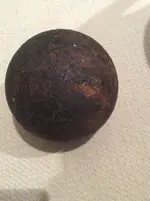You said the iron ball weighs 33 pounds and is 6 inches in diameter. That is very close to the US 1861 Ordnance Manual's specifications for a 32-Pounder caliber Solid-Shot cannonball.
Cannon bore, shot, and shell diameters for smoothbore guns
The size-&-weight chart there says a civil war era 32-Pounder Solid-Shot weighed 32.4 pounds (32 lbs. 6.4 ounces), and was 6.25-inches in diameter. To be sure about your ball's identity, you'll need to weigh it on a Postal Shipping scale, because typical household bathroom scales are notoriously inaccurate. Also, try to get a professional to measure its diameter WITHOUT the size-increase caused by the rust encrustation on it.
As the Ordnance Manual's chart says, civil war ones were 6.25-inches in diameter. But Revolutionary War and War-Of-1812 ones were a bit smaller (6.20-inches), and slightly lighter (closer to 32.0 pounds).
If weighing it on a Postal Shipping scale says that ball weighs more than the Ordnance Manual says, such as 33 or 34 pounds, it is not a cannonball.
I always HOPE a mystery-ball posted here at TreasureNet will turn out to actually be a cannonball. But, literally multi-millions of iron/steel balls have been manufactured for civilian usage, such as Mill-Balls, ball-bearings, Ornamental Ironwork balls, and Sports Shot Put balls. So, cannonball collectors (like me) have to rely on very-precise measuring of diameter and weight to know with certainty whether it is or isn't a cannonball.




